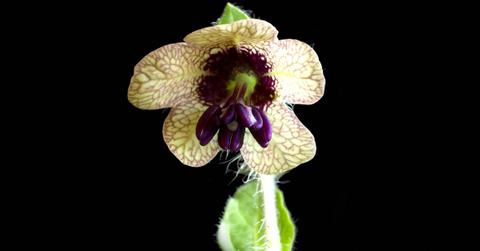Witchy Mystery: Study Reveals Ancient Roman Healing Plant Linked to Dark Magic

A plant called 'black henbane' was once revered by ancient Romans for its healing properties, yet feared as an element of dark magic due to its strong psychoactive effects, according to a new study.
Recent research has shed light on the multifaceted history of black henbane, a potent plant held in both reverence and fear by ancient Romans.
This study, detailed in the journal Antiquity recently, unveils the dual nature of this botanical wonder, cherished for its medicinal attributes yet also steeped in associations with dark magic and psychoactive properties.
Ancient Romans utilized black henbane, scientifically known as Hyoscyamus niger, as a remedy for various ailments, from pain relief to fever reduction.
However, alongside its therapeutic applications, evidence suggests that it was integrated into rituals involving witches' concoctions and the summoning of otherworldly entities.
Researchers from the Netherlands and Germany, in their groundbreaking study, revealed the intentional collection and utilization of black henbane seeds in the Roman Netherlands, marking a pivotal discovery in understanding its historical significance.
The plant, known for its toxicity, could induce psychoactive effects, rendering it suitable for both medicinal and ritualistic purposes.
The versatility of black henbane is evident in its various applications. Its seeds were employed in medicinal concoctions to alleviate pain and treat gynecological issues, while its leaves provided relief from discomfort.
However, caution was necessary, as improper preparation could lead to sensory disturbances and potentially harmful effects.
- What Lies Beneath: NASA Scientist Believes Aliens May Have Found 'Perfect' Hiding Spot in Earth's Oceans
- Global Threat: Russia Insider Warns West of 'World War Using Nuclear Weapons' Amid Escalating Support for Ukraine
- Countdown to Disaster? Ex-NATO Official Warns Russia, Iran and China Could Wage WWIII in Just Years
Archaeological findings spanning from the Neolithic period to medieval times in the Netherlands underscore the enduring presence of black henbane in human culture. Medieval texts attribute magical properties to the plant, associating it with rain summoning, demon invocation and even hunting rituals, owing to its hallucinogenic qualities.
The focal point of the study was an intriguing artifact discovered at Houten-Castellum, a Roman settlement in the Netherlands.
Never miss a story — sign up for the Front Page Detectives newsletter. Be on the scene the moment news breaks.
This artifact, a hollowed-out animal bone filled with black henbane seeds, offered valuable insights into the intentional use of the plant in ancient practices, emphasizing its dual role as both medicine and mystical component.
The widespread distribution of black henbane across archaeological sites in Europe suggests its significance in ancient civilizations. Its presence may have been influenced by early farmers, who possibly introduced the plant intentionally or inadvertently to new regions.
Despite the enigmatic aura surrounding black henbane, historical accounts hint at a nuanced understanding of its psychoactive properties. Figures like Dioscorides and Pliny the Elder cautioned against its potent effects, highlighting its dual nature as both a potent remedy and a potential source of harm.
Become a Front Page Detective
Sign up to receive breaking
Front Page Detectives
news and exclusive investigations.
